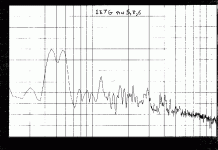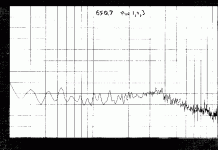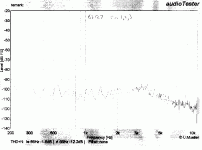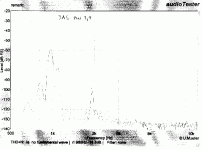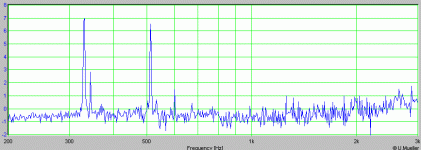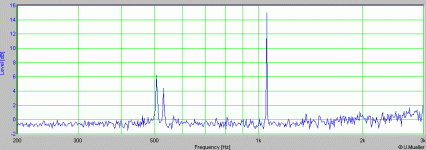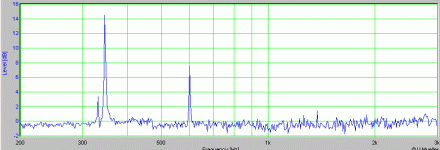salas said:
Or you can press the key labeled "Prt Scr" and that will copy in the clipboard the screen. You can do "paste" in Paint and crop what you don't like. Save As - choose jpg.
Smoking-amp,
what is the frequency range in your pics?
45
Contact this guy for your next test :
:
http://www.youtube.com/watch?v=bj9TMzPVdi8&feature=related
what is the frequency range in your pics?
45
Contact this guy for your next test
http://www.youtube.com/watch?v=bj9TMzPVdi8&feature=related
Seeing as the DHTs are 100s of times more sensitive to microphonics than indirectly heated tubes (40+ dB), it will be interesting to see if the more microphonic tubes have better DHT sound or not.
When I get my Hammond 124B xfmr, I will test the different tubes for sound "quality". Then I am thinking that if there is a correlation with the microphony, then I could try one of the lesser microphonic ones and tumble it in a rubber lined rock tumbler bucket for a few days to loosen up the mica supports. Then check the sound. Maybe I can even "manufacture" the magic gong tubes that way. (I should make a .wav recording of that tube, its an incredible sounding bong yeonnng wonnng onnng ....)
The strong 588 Hz resonance on the 1J6G tube I initially measured had a very narrow resonance frequency (only about 10 Hz wide for exiting it from the computer sound card generator) and a very high Q. It would ring for several seconds after I removed the stimulus.
Don
When I get my Hammond 124B xfmr, I will test the different tubes for sound "quality". Then I am thinking that if there is a correlation with the microphony, then I could try one of the lesser microphonic ones and tumble it in a rubber lined rock tumbler bucket for a few days to loosen up the mica supports. Then check the sound. Maybe I can even "manufacture" the magic gong tubes that way. (I should make a .wav recording of that tube, its an incredible sounding bong yeonnng wonnng onnng ....)
The strong 588 Hz resonance on the 1J6G tube I initially measured had a very narrow resonance frequency (only about 10 Hz wide for exiting it from the computer sound card generator) and a very high Q. It would ring for several seconds after I removed the stimulus.
Don
Thanks Don,
Great work! What happens if one parallells the the two halves of a tube like 3A5? Are the resonances adding up to one giant peak or do they in some way compensate each other? The latter is just wishful thinking !
!
One option I will try with this little tube is to run it in parallell as shown in a previous post and also pot it in silicone rubber to see what happens. It is not running very hot with heaters ca 1,5V/230mA and triodes 90V/2*4mA so I reckon it will stand
Great work! What happens if one parallells the the two halves of a tube like 3A5? Are the resonances adding up to one giant peak or do they in some way compensate each other? The latter is just wishful thinking
 !
!One option I will try with this little tube is to run it in parallell as shown in a previous post and also pot it in silicone rubber to see what happens. It is not running very hot with heaters ca 1,5V/230mA and triodes 90V/2*4mA so I reckon it will stand
smoking-amp said:Seeing as the DHTs are 100s of times more sensitive to microphonics than indirectly heated tubes (40+ dB), it will be interesting to see if the more microphonic tubes have better DHT sound or not.
Well, those spectra remind me some hi-end tone-arms in comparison to the little Rega RB250....
For me the microphonic effect must be eliminated, together with any kind of vibration in audio equipment, starting from the source.
In the place where I work people use air springs for vibration free operation of sensible instrumentation. This is really the only thing that works efficiently from subsonic frequency to several hundred kHz's.
Less efficient, however more than sufficient for the valves, and much less expensive than air springs are these:
www.geltecsh.com.cn/catalog/pdf/pro_02.pdf
Originally posted by smoking-amp
When I get my Hammond 124B xfmr, I will test the different tubes for sound "quality". Then I am thinking that if there is a correlation with the microphony, then I could try one of the lesser microphonic ones and tumble it in a rubber lined rock tumbler bucket for a few days to loosen up the mica supports. Then check the sound. Maybe I can even "manufacture" the magic gong tubes that way. (I should make a .wav recording of that tube, its an incredible sounding bong yeonnng wonnng onnng ....)
The strong 588 Hz resonance on the 1J6G tube I initially measured had a very narrow resonance frequency (only about 10 Hz wide for exiting it from the computer sound card generator) and a very high Q. It would ring for several seconds after I removed the stimulus.
Don
From my point of view microphony introduces masking ( i.e. loss of detail etc...).
If you want to damp just the bulb of a signal tube and for a quick experiment, use soft gel rings.... those ones for the foot fingers.
45
www.geltecsh.com.cn/catalog/pdf/pro_02.pdf
Where do we buy those?
I don't like to tell other people to do tests, but I just don't have any DHTs around...
Anyway, here's something I'd suggest: put a speaker nearby the tube (set up with the grid at AC ground), run an MLS signal through the speaker, then do the autocorrelation/FFT on the tube's output. That's all easily do-able with standard software and a soundcard.
Anyway, here's something I'd suggest: put a speaker nearby the tube (set up with the grid at AC ground), run an MLS signal through the speaker, then do the autocorrelation/FFT on the tube's output. That's all easily do-able with standard software and a soundcard.
First time I heard a SE DHT, was with an 845 amp. It had that midrange "bloom", where the midrange (esp. female voice) seemed to move out to the listener. I don't know that it was necessarily louder. Interesting effect, but I thought I'd tire of it. I haven't heard a DHT pre, so I don't know if this is what Andy hears. But it's conceivable that the effect was due to some physical excitation of the tube internals. One wouldn't expect to see a circuit driven boost in midrange response for most amps with a resistive load. At least I've never seen that in my amps.
If it is a physical phenomenon, then it should be modulated by changes that change the coupling of the tube to the sound field, including changes in room position. That was the reason for asking about headphones earlier. Don's measurements suggest a means of selecting tubes for matching (or at least similar) characteristics in this regard. Don't know how important right to left match is here, but it seems like it could be audible.
Sheldon
If it is a physical phenomenon, then it should be modulated by changes that change the coupling of the tube to the sound field, including changes in room position. That was the reason for asking about headphones earlier. Don's measurements suggest a means of selecting tubes for matching (or at least similar) characteristics in this regard. Don't know how important right to left match is here, but it seems like it could be audible.
Sheldon
and here is a scan of just one triode section of the 19 tube.
Oh, I forgot to reduce the plate CCS current down from running both sections, so this is still at 4 mA. The resonances have bigger peaks now, but I think this is mainly due to the other (non resonating at the same freq.) plate not shunting it out as in the dual paralleled scan.
Oh, I forgot to reduce the plate CCS current down from running both sections, so this is still at 4 mA. The resonances have bigger peaks now, but I think this is mainly due to the other (non resonating at the same freq.) plate not shunting it out as in the dual paralleled scan.
Attachments
and the other half of the 19: (still at 4 mA)
Its odd that the dual plot does not seem to be quite the sum of the two (although plate to plate shunting would be expected to swamp the non-aligned resonances some). Since both tube sections were connected in parallel for the dual plot, it could be that the equal grid biasing was more optimal for one section, so that side dominated the response.
For the case with the tube sections split between P-P sides, as originally posted, I would expect both sections to contribute equally.
Don
Its odd that the dual plot does not seem to be quite the sum of the two (although plate to plate shunting would be expected to swamp the non-aligned resonances some). Since both tube sections were connected in parallel for the dual plot, it could be that the equal grid biasing was more optimal for one section, so that side dominated the response.
For the case with the tube sections split between P-P sides, as originally posted, I would expect both sections to contribute equally.
Don
Attachments
I'm new to the tube thing, so I'm following this thread with great interest.
I recently built a Decware ZSP1 preamp with 6N1P DHT's.
What is the most critical vibrations to damp - mechanical (i.e. through the chasis) or airbourne?
What about tube damping rings?
Cheers,
Alex
I recently built a Decware ZSP1 preamp with 6N1P DHT's.
What is the most critical vibrations to damp - mechanical (i.e. through the chasis) or airbourne?
What about tube damping rings?
Cheers,
Alex
Well, I'm no expert on acoustics or damping. But the earlier plots above were from tapping the tube and measuring internal resonances, while the later plots were from conducted external feedthru airborne from a speaker.
The speaker/airborne responses appear to lack the higher freq. peaks seen in the self resonance plots. So maybe the glass tube inertia shields HF thru air already. The rubber ring dampers around the tube would mainly be stopping HF.
When I had the amplifier/speaker connected to the tube output earlier, I could hear the fan running in the computer when I set the tube down on the table. Made a good microphone. So looks like conducted noise thru the chassis is the major threat to me. Humming power transformers on the chassis would be a big concern I would think.
Some sort of pliant socket suspension would seem essential.
It still needs to be tested whether a headphone (instead of a speaker) affects the sound of the DHT or not. If it does, then maybe sound damping will just kill the magic DHT effect too.
It could be that the DHT tube acts as a microphone, and by picking up a delayed acoustic signal, it provides a reverberation like affect. If so, then one might be able to emulate DHT sound by connecting an attenuated microphone to an amplifier input (so summing with the input signal). Or maybe use a spring reverberation unit pickup, without sound shielding, for an acoustic pickup.
Don
The speaker/airborne responses appear to lack the higher freq. peaks seen in the self resonance plots. So maybe the glass tube inertia shields HF thru air already. The rubber ring dampers around the tube would mainly be stopping HF.
When I had the amplifier/speaker connected to the tube output earlier, I could hear the fan running in the computer when I set the tube down on the table. Made a good microphone. So looks like conducted noise thru the chassis is the major threat to me. Humming power transformers on the chassis would be a big concern I would think.
Some sort of pliant socket suspension would seem essential.
It still needs to be tested whether a headphone (instead of a speaker) affects the sound of the DHT or not. If it does, then maybe sound damping will just kill the magic DHT effect too.
It could be that the DHT tube acts as a microphone, and by picking up a delayed acoustic signal, it provides a reverberation like affect. If so, then one might be able to emulate DHT sound by connecting an attenuated microphone to an amplifier input (so summing with the input signal). Or maybe use a spring reverberation unit pickup, without sound shielding, for an acoustic pickup.
Don
- Status
- This old topic is closed. If you want to reopen this topic, contact a moderator using the "Report Post" button.
- Home
- Amplifiers
- Tubes / Valves
- Is it worth using anything other than DHTs for preamps?
